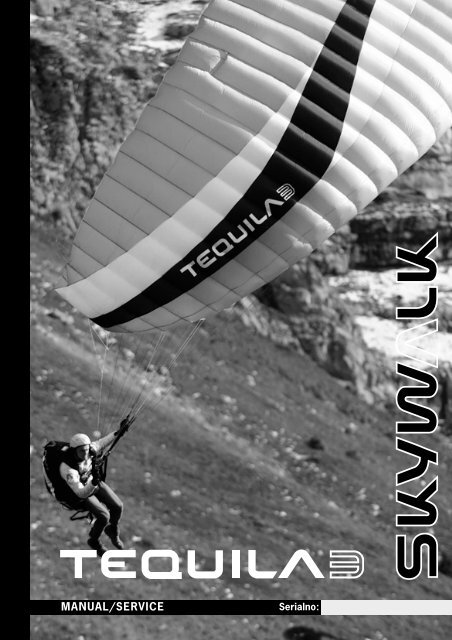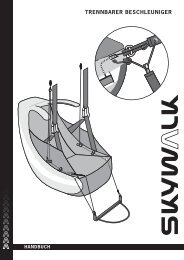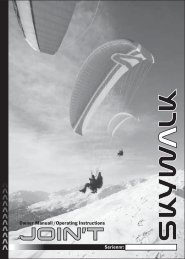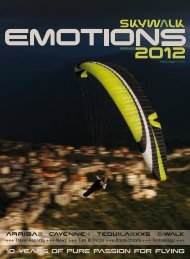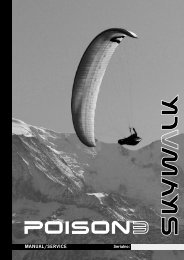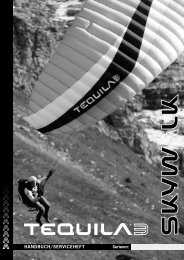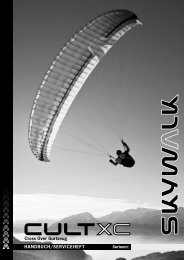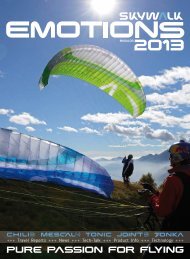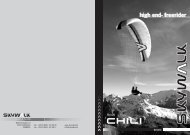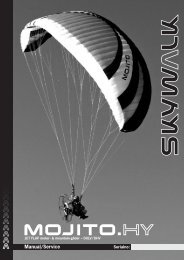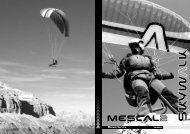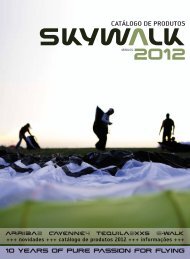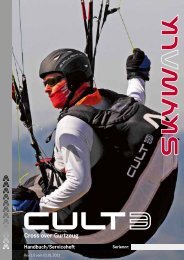Tequila3_E - Skywalk
Tequila3_E - Skywalk
Tequila3_E - Skywalk
Create successful ePaper yourself
Turn your PDF publications into a flip-book with our unique Google optimized e-Paper software.
Manual/Service<br />
37
CONTENT<br />
Introduction Page 39<br />
Description Page 40<br />
Technical Data Page 41<br />
Line System Page 42<br />
Speed System Page 44<br />
Harness Page 45<br />
Flying Technique and Flying Performance Page 46<br />
Descent Techniques Page 51<br />
Extreme Flights Manoeuvers Page 54<br />
Materials Page 57<br />
Maintenance Page 58<br />
Disposal Page 59<br />
Nature and ecological compatibility Page 60<br />
2-Year check Page 61<br />
Certification Page 61<br />
Summary Page 62<br />
Line Plan Page 63<br />
Risers Page 64<br />
Test Protocol Page 68<br />
38
Introduction<br />
Thank you for choosing a skywalk Paraglider! We are sure that your trust will be<br />
rewarded with many hours of flying pleasure. So that you will feel comfortable<br />
with your glider from the very beginning, we recommend that you read this manual<br />
carefully. This way you can thoroughly and quickly acquaint yourself with your skywalk<br />
TEQUILA3.<br />
This operating manual will give you tips for safe and confident flight, so that you will<br />
enjoy many flying hours with your TEQUILA3. For helpful suggestions, questions or<br />
critic, please call or send us an e-mail. The skywalk Team is gladly at your disposal.<br />
The <strong>Skywalk</strong> Team<br />
39
Description<br />
The TEQUILA has become a legendary wing, its range of use vastly diversified since it<br />
was first introduced to the market. Whether talented novice or occasional xc pilot: the<br />
TEQUILA always was and remains an excellent choice for a wide variety of pilots. With<br />
innovative 3-line technology and rigid foil, the TEQUILA3 now takes things to the next<br />
level.<br />
JET FLAP Technology has become completely accepted in the past few years, and<br />
consequentially, the TEQUILA3 is constructed with an advanced slotted flap. Along with<br />
optimal climb performance, the JET FLAPS guarantees low landing speeds and high<br />
safety potential.<br />
A great deal of testing and the use of the newest CAD software have produced a<br />
product that will surely prove to be trendsetting. The TEQUILA3 may also be used as an<br />
instruction wing, thanks to the safety potential. Furthermore, this is a real intermediate<br />
glider, thanks to the combination of a high level of safety and performance; a guarantee<br />
for long and relaxed flights.<br />
40
Technical Data<br />
Typ XS S M L XL<br />
Size XS S M L XL<br />
Cells 44 44 44 44 44<br />
Surface Area (flat) 23.3 26.2 28.8 31.0 32.7<br />
Flat Span: 11.11 11.77 12.35 12.8 13.16<br />
Flat Aspect Ratio 5.3 5.3 5.3 5.3 5.3<br />
Projected Area 19.6 22 24.2 26 27.5<br />
Projected Span 8.57 9.09 9.53 9.88 10.16<br />
Projected Aspect Ratio 3.75 3.75 3.75 3.75 3.75<br />
Canopy weight kg 4.9 5.5 6.1 6.6 6.9<br />
Launch weight from – to in kg. 60-80 75-95 90-110 100-120 110-135<br />
This paraglider meets the demands of the regulations of German Airworthiness<br />
Regulations-LTF, or the EN norm. Further details of the construction and the<br />
measurements are described in the DHV type sheet, which is part of this manual.<br />
The measurements of the line elements are listed in the type sheet or in the<br />
lineplans.<br />
IMPORTANT SAFETY WARNING:<br />
THE IDENTIFICATION PLATE IS PRINTED ON THE INSIDE OF THE STABILO.<br />
HERE THE DATE AND PILOTS NAME OF FIRST FLIGHT MUST BE ENTERED.<br />
THE MODEL INSPECTION TAG IS LOCATED ON THE MIDDLE RIB. IT MUST BE<br />
SIGNED IN.<br />
IF THE PRINT IS MISSING ITS OBVIOUS THAT THE GLIDER IS A NOT INSPECTED<br />
PROTOTYPE.<br />
41
Line System<br />
The lines of the TEQUILA3 have a very high level of strength with a very small diameter,<br />
thanks to comprehensive testing. The line controls, as well as the effectivity of the<br />
speed system, are important matters for us. Safety always remains in the foreground<br />
during all of the considerations and calculations. For this reason, we have implemented<br />
an elaborate combination of Liros Dyneema and Tecnora lines.<br />
The skywalk TEQUILA3 is equipped with 3 A-, 3 B- as well as 3 C and 1 stabilo line.<br />
The top lines of the last cells attach to the stabilo – main line, together with the stabilo<br />
toplines, which lead Directly to the B-riser.<br />
The brake lines are not load bearing and lead from the trailing edge of the wing over<br />
the main brake line throught the brake pulley on the C-riser to the brake handle. There<br />
is a mark on the main brake line where the brake handle is knotted. This adjustment<br />
should not be altered, on one hand to assure adequate brake travel when landing and<br />
on the other hand to avoid constant braking.<br />
For better recognition, the A-lines and the A-riser are red and the stabilo line is pink.<br />
The B-lines are yellow, the main brake line and the brake spider are orange and all other<br />
lines are blue.<br />
The line locks are triangular, a plastic insert prevents the lines from slipping.<br />
The skywalk TEQUILA3 has five risers on each side.<br />
Both of the inner A-main lines lead to the A-riser, the outer A-lines lead to the rear<br />
A-riser.<br />
> The B-lines and the stabilo line lead to the B-riser.<br />
> The outermost C-main line leads to the front C-riser and both of the inner C-main lines<br />
lead to the rear C-riser.<br />
An illustration of the risers can be found at the end.<br />
42
IMPORTANT SAFETY WARNING:<br />
Flying a paraglider requires maximum caution at all times.<br />
Be aware that as a paragliding pilot, you fly at your own risk. As a<br />
pilot you have to guarantee the airworthiness of your paraglider<br />
before every single flight.<br />
Don’t use your skywalk TEQUILA3 :<br />
> > You are outside of the certified launch weight.<br />
> > With any engine<br />
> > In rainy, snowy and extremely turbulent weather conditions or high winds<br />
> > In fog or clouds<br />
> > With insufficient experience or training<br />
> > With a motor, unless there is certification from DULV or motorgliding association<br />
Every pilot is responsible for their own safety and must ensure that their aircraft<br />
(paraglider) has been checked and serviced for its airworthiness before flying.<br />
You can only fly your skywalk TEQUILA3 with a valid flying license and in accordance<br />
with local rules and regulations. During the production of your skywalk TEQUILA3, the<br />
glider has passed multiple quality controls. More spot checks were performed before<br />
delivery to the dealer.<br />
43
Speed System<br />
The skywalk TEQUILA3 can be equipped with a foot-operated speed system.<br />
Caution:<br />
THE DHV RATING OF SOME GLIDER SIZES CAN CHANGE DURING THE<br />
USE OF THE SPEED SYSTEM IN FLIGHT. TO DETERMINE WHICH SIZES<br />
ARE AFFECTED PLEASE CHECK THE TYPE SHEET.<br />
The speed system works on the A-, B- and front C-Riser. Exact specifications can be<br />
found on the riser drawing.<br />
Installing the accelerator equipment:<br />
Most commonly used harnesses have pulleys<br />
for the speed system already attached. The<br />
acceleration line runs from the front through the<br />
pulleys at the harness to the top. They are tied<br />
to the ”Brummel-hooks” at the right length.<br />
With the right adjustment of the acceleration<br />
lines, the foot-bar can be reached easily<br />
with angled legs during flight. By straightening<br />
the legs, the entire speed range can be used.<br />
Prior to flying, the connection hooks of the footoperated<br />
accelerator and the speed system<br />
have to be connected to each other (Brummel-hooks). Check that the acceleration line<br />
runs freely.<br />
Function:<br />
By using the foot-operated speed system the pilot reduces the force via a pulley-system<br />
by half and shortens the A-, B- and C- risers.<br />
Speed System Risers Illustrated on page 64-66.<br />
44
Harness<br />
The skywalk TEQUILA3 is licensed for all certified harnesses of the GH type<br />
(harnesses without solid cross-bracing).Be aware that the level of suspension changes<br />
the relative braking distance.<br />
CAUTION:<br />
FULLY CROSS-BRACED HARNESSES INFLUENCE HANDLING DRASTICALLY<br />
AND DO NOT LEAD TO HIGHER SAFETY!<br />
45
Flight Techniques and Performance<br />
Preflight check and maintenance<br />
It is important to check all paragliding equipment thoroughly before every flight to<br />
inspect for defects. Also check the paraglider after long flights and after long periods<br />
of storage.<br />
Check thoroughly:<br />
> > All seams of the harness, of the risers and of the reserve bridle<br />
> > That all connecting parts, maillons and carabiners are closed<br />
> > The brake-line knots on both sides and follow the brake-line to the top<br />
> > All the other lines from riser to canopy<br />
> > All the line attachment points at the canopy<br />
> > If the top or bottom of the wing has partial damage or is highly damaged<br />
> > The ribs and crossports from inside<br />
CAUTION:<br />
DO NOT LAUNCH IF YOU DETECT ANY DEFECTS, EVEN IF THEY ARE MINOR!<br />
If you find any damage or excessive wear and tear please get in touch with your flying<br />
school.<br />
Laying out the glider:<br />
If you use your paraglider for the first time we recommend that you practice some<br />
inflations and try some simple flights at a training site. This way you are able to get<br />
used to your skywalk TEQUILA3. Lay out the canopy so that the leading edge is slightly<br />
arched. The middle of the canopy should form the deepest point of the paraglider. This<br />
way the A-lines are tensioned first in the middle whilst inflating. The paraglider inflates<br />
evenly which ensures a stable and straight take off. Separate A, B, C, D-lines and risers<br />
and put in order. Make sure that the brake lines run freely through the pulleys to the<br />
trailing edge of the paraglider. All lines have to run freely without any knots and twists<br />
from the risers to the canopy. During flight, tangled or crossed lines can often not be<br />
released or untangled! The brake-lines are lying Directly on the ground, so please pay<br />
attention that they do not become entangled during launch. There shouldn’t be any lines<br />
beneath the canopy during launch. Line-overs can have fatal consequences!<br />
46
The Launch:<br />
The skywalk TEQUILA3 is very easy to launch. Hold the two A-risers and the brake<br />
handles in your hands. For a better identification, the A-lines and covers at the A-risers<br />
are coloured red. The brake lines are coloured yellow and the brake handles are black.<br />
Hold your arms slightly sideways and backwards like an extension of the A-risers.<br />
Before launching check the laid out glider. Further check the wind Direction and the<br />
airspace!<br />
Pull rapidly and the canopy of the skywalk TEQUILA3 will launch and rise above your<br />
head. The canopy will inflate fast and reliably. Keep the paraglider straight above<br />
your head and run forward. Slow down a little as soon as the upward pull decreases.<br />
You can open any collapsed cells by pumping the affected side. Changes of Directions<br />
that are necessary can be carried out now. Look and feel that the wing is properly<br />
inflated. Don’t make your final decision to accelerate or to take-off until you are<br />
absolutely sure that the wing is properly and evenly inflated. Otherwise, stop the launch<br />
procedure immediately! During reverse launches and in strong winds, it is possible that<br />
the paraglider surges forward and inflates faster than intended. You can counteract<br />
this by running towards the glider. We recommend practicing this demanding launch<br />
technique on a flat slope! If you reverse launch it is advisable to only use the inside<br />
A-risers.<br />
This way the glider opens a bit more slowly and in strong winds you don’t have to deal<br />
with the full pressure at once.<br />
The TEQUILA3 is also equipped with the innovative JET FLAP System. Air is conducted<br />
from the bottom sail (pressure area) to the top sail (low-pressure area) and is blown<br />
out there with higher speed. The connection is established through jet-shaped<br />
channels, which are located in the rear section of the wing. When increasing the<br />
angle-of-attack the danger of airflow interruption and subsequent stall is minimized.<br />
Results: the constant airflow even at great angles-of-attack delays the stall, the flyable<br />
minimum speed is lowered and the pilot has a higher incidence range. This is of great<br />
importance, especially during launch and landing. Of course, the JET FLAPS are no<br />
reason for uncontrolled braking, but the slow flight characteristics of the TEQUILA3<br />
profit immensely.<br />
You don’t need any special knowledge to have control of the JET FLAP System, the use<br />
of a JET FLAP paraglider is the same as a conventional glider.<br />
Turning:<br />
The skywalk TEQUILA3 is very manoeuvrable and reacts to steering inputs directly and<br />
without delay. Simple weight shift enables you to fly very wide turns with minimal<br />
47
altitudeloss. Combined steering technique: Weight shifting and pulling of the inside<br />
brake line allow extra tight turns. During turning you can control the speed, the curve<br />
radius and banking by additional use of the outer brake. Counter braking or releasing<br />
the brake lines can change these parameters most effectively.<br />
CAUTION:<br />
PULLING THE BRAKE LINES TO FAR AND TO FAST CAN CAUSE A FULL<br />
STALL!<br />
You will recognise a flat spin through high steering pressure and a slight backwards<br />
folding of the outer wing section. If this happens you have to release the inside brake<br />
immediately.<br />
Emergency Steering:<br />
IIf one brake line tears or releases from the brake handles, you will still have limited<br />
steering and landing capability of the skywalk TEQUILA3 with the aid of the C-risers.<br />
Active Flying:<br />
Active flying means flying in harmony with your paraglider. Anticipate the behaviour<br />
of your skywalk TEQUILA3 in flight, especially in turbulent and thermal conditions and<br />
react accordingly. In calm air necessary corrections will be minimal, but turbulence<br />
demands permanent attention and the use of brakes and weight shifting with the<br />
harness.<br />
Good pilots have instinctive reactions. It is important that you always have Direct<br />
contact to the canopy by slight pressure on the brakes in order to feel the stored<br />
energy<br />
of the glider. This way you will recognise a loss of pressure in your canopy and<br />
subsequent collapse early and are able to react in time. TEQUILA3 is featured with<br />
a profile that mitigates turbulences. This provides high resistance against collapses,<br />
however it can happen without a pilots reaction.<br />
Examples:<br />
> > When flying into strong thermals, you have to release the brakes.<br />
> > When flying into falling airstream, pull the brakes. This way you can avoid extensive<br />
changes in the angle of attack.<br />
48
In turbulent air, you feel the release in pressure on parts of the glider through the<br />
feedback from your brakes. You can balance this by quickly pulling the brake a little<br />
more until the pressure returns. Always apply brakes softly and progressively.<br />
> > Don’t slow down your glider too fast as this can increase the danger of stalling!<br />
> > By active flying you can avoid almost all deformations of the glider in advance.<br />
Accelerated Flying:<br />
To use the speed system you will need to make some effort. This can affect the<br />
sitting position in the harness. Therefore we recommend an upright position in the<br />
harness. Adjust the harness before your first attempt of accelerated flight. We remind<br />
you to only fly in wind conditions that don’t require constant use of the speed system.<br />
To reach the maximum speed press the speed bar firmly until both pulleys<br />
on the A-risers touch each other. As soon as you apply the speed system, the angle of<br />
attack will be reduced, the speed increases, but the paraglider becomes less stable<br />
and can collapse more easily. Therefore always use the speed system with adequate<br />
altitude from the ground, obstacles and other aircraft.<br />
Avoid flying with too short brake lines.<br />
Accelerated collapses are normally more impulsive and demand fast reactions<br />
NEVER ACCELERATE IN TURBULENT AIR!<br />
NEVER ACCELERATE NEAR THE GROUND<br />
NEVER LET GO OF THE BRAKE HANDLES!<br />
In case the glider collapses you will have to release the acceleration-system<br />
immediately to stabilise and reopen your paraglider.<br />
Landing:<br />
The skywalk TEQUILA3 can be landed easily. Make your final approach against the<br />
wind and let the glider slow down at its own rate. Further reduce the speed by applying<br />
the brakes lightly and evenly. At about 1m above the ground you increase the angle<br />
of attack by slowing down more and eventually completely flare out the glider. When<br />
you have reached the minimal speed apply full brake. In strong head winds, slow down<br />
carefully. When you have reached the ground safely, stall the glider warily. Avoid turning<br />
sharply before your final approach. This increases the danger of pendulum effect!<br />
49
Winchtowing:<br />
The skywalk TEQUILA3 is very suitable for towing. Make sure you climb from the<br />
ground at a flat angle.<br />
> > Pilot must be instructed in towing.<br />
> > Pilot must use a certified winch.<br />
> > Winch driver must be instructed in towing.<br />
When towing please steer carefully, do not over-brake, the glider will fly with an<br />
increased angle of approach.<br />
Motorised flight:<br />
You can inform yourself about the current status of certification of motorised flight<br />
at your dealer, national distributor or Directly through us. No certification existed at the<br />
time the handbook went to print. (April 2011)<br />
Carefully packing your paraglider wil increase its longevity.<br />
Your skywalk TEQUILA3 is equipped with reinforcements made from flexible nylon slats<br />
in the leading edge. The material used, Superflex, is very resistent to bending and<br />
requires no special handling.<br />
> > Empty the glider from all debris such as leaves, twigs, grass, sand etc.<br />
> > Sort out your lines and spread them evenly on the glider.<br />
> > Make sure the glider is dry when storing it for a longer period of time.<br />
> > Fold the glider starting in the middle and working your way to the outside always<br />
folding 2 cells, so that the leading edge is folded cleanly.<br />
> > Fold the cells, starting from the second cell from the middle, so that the<br />
reinforcededges of the cell openings are on top of each other.<br />
> > Do the same at the lower long-edge of the glider.<br />
> > This folding method is best done together with a friend, but you should be able to do<br />
the same on your own after some practice.<br />
> > Then press the air out of the folded glider starting at the bottom and working your<br />
> > way to the top.<br />
> > Fold the whole row once toward the middle.<br />
> > Do exactly the same on the other side. Then fold one half onto the other half<br />
andmake sure the leading edge are folded cleanly.<br />
> > Start wrapping up the glider from its lower end. The wraps should be approx. 1ft.<br />
wide.<br />
50
The leading edge can be folded inwards once, but is not necessary. The left over<br />
airshould be pressed out of the glider and not through the material (this can increase<br />
the porosity of your glider).<br />
> > Now attach the compression band around the packed wing, at right angles to the cell<br />
openings, then slide the glider into the light nylon bag. This helps to protect the cloth<br />
from being damaged by sharp edges or zippers from your harness.<br />
> > Open the backpack and place your glider on the inside edge. The soft wing on your<br />
back will make transportation much more comfortable.<br />
> > Place the harness with the seat board facing up on top of your glider and close the<br />
zippers.<br />
> > Put the rest of your equipment (helmet, overall, instruments etc.) under the hood of<br />
your backpack.<br />
Descent Techniques<br />
The TEQUILA3 manual is not a textbook for learning how to paraglide.<br />
According to the local rules and regulations, instruction and training must be carried<br />
out in licensed schools. The following information enables you to get the most<br />
out of your skywalk TEQUILA3 .<br />
Spiral dive:<br />
You can initiate the spiral dive by carefully increasing the pull on one of the brakes<br />
and simultaneously shifting your weight to the inside of the turn. If the glider doesn’t<br />
bank up and the sink rate doesn’t increase, then try again. Don’t just apply more and<br />
more brake without sensitivity. The skywalk TEQUILA3 enters the spiral dive with a high<br />
bank angle and makes a fast steep turn. The banking and sinking can be controlled by<br />
dosed pulling resp. loosening the inner brake line. Smooth braking of the outer wingtip<br />
not only helps to avoid collapses, the pilot is also more easily able to control the rate<br />
of sink. The spiral is the most effective tool in losing altitude. This is advantage and<br />
disadvantage at the same time, the pilot needs to be able to handle the resulting high<br />
sink rates.<br />
51
CAUTION:<br />
THE HIGH SINK RATE CAUSES HIGH PHYSICAL STRAIN DUE TO THE<br />
INCREASING CENTRIFUGAL FORCES AND MAY CAUSE BLACKOUTS!<br />
Tensing the stomach muscles during the spiral dive can be helpful. At the first signs<br />
of dizziness or feeling faint exit the spiral dive immediately. Because of the extreme<br />
loss of altitude experienced during a spiral dive always ensure you have enough altitude<br />
above ground. To avoid a strong surge when exiting the spiral dive you have to release<br />
the inside brake while applying the outer brake slightly. The skywalk TEQUILA3 has<br />
no tendency for locking into a spiral dive. In case it keeps turning under unfavourable<br />
circumstances (e.g. unintended asymmetry of the cross brace harness) you will have<br />
to actively finish the spiral dive. In this case shift your weight to the outside of the turn<br />
and simultaneously apply more outside brake. Applying both brakes will also take the<br />
paraglider out of the spiral dive but the glider can front tuck and you should dampen<br />
the exit with the brakes. Remember: Compared to regular flight manoeuvres the<br />
steering forces in a spiral dive are a lot higher<br />
B-line stall:<br />
The B-lines are pulled down symmetrically (20cm). Keep the brake handles in the<br />
hands. The airflow on top of the profile largely detaches and the paraglider descends<br />
without flying forward. By pulling the B-lines stronger the canopy surface decreases<br />
and the descent increases. You can exit the stall by quick and symmetric release of the<br />
B-lines. The paraglider will pitch forward and pick up speed. At no time you may use<br />
the brakes in this case! You must exit the B-line stall immediately if the canopy starts<br />
to form a forward facing semi-circle. If the wing doesn’t reopen you may speed up the<br />
opening process by gently braking. Because the TEQUILA3 is equipped with a 3-line<br />
system, the pressure on the B-riser is somewhat higher than the pressure on a glider<br />
with 4 line levels. This somewhat higher pressure is, however, rewarded with higher<br />
sink in the stall.<br />
Big ears:<br />
In contrast to the spiral dive and B-line stall, big ears result in an increase of forward<br />
speed in relation to the gliders sink rate. Big ears is used to avoid or exit dangerous<br />
areas in a horizontal Direction.<br />
52
Examples:<br />
> > In strong winds or below a thundercloud at low altitude it is possible that neither<br />
B-line stall or spiral dive will help. Big ears are the easy way out.<br />
> > If the pilot is stuck in strong lift and needs to look for sink it is advisable to exit the<br />
lift band with the use of big ears.<br />
> > To fold the outer wingtip you only need to pull the outer A-lines symetrically. In<br />
doingso it make sense to grap the lines as far up as possible for folding maximum<br />
area.<br />
> > The skywalk TEQUILA3 will enter now a stable sink flight.<br />
> > The brake handles are held together with the outer A-lines.<br />
> > Braking and weight shift enables you to steer your paraglider.<br />
> > In order to increase the sink and forward speed you can optimise this manoeuvre by<br />
using the acceleration-system.<br />
> > The risk of canopy destabilisation in turbulent air is clearly reduced when using big ears.<br />
> > To exit big ears release the A-lines. The canopy will unfold automatically.<br />
> > You may brake a little to support the unfolding. It is advisable to pump out one side<br />
at a time to reduce the risk of detaching airflow.<br />
CAUTION:<br />
ALL DESCENT TECHNIQUES SHOULD BE ADEQUATELY TRAINED IN NON-<br />
TURBULENT CONDITIONS AND WITH SUFFICIENT ALTITUDE BEFORE<br />
IMPLEMENTING THEM IN EMERGENCY SITUATIONS<br />
AND IN TURBULENT CONDITIONS.<br />
Any extreme flight manoeuvre and descent technique demands:<br />
> > Training, either with an instructor in a paragliding school or during a security training<br />
course.<br />
> > Double-checking that before entering a manoeuvre you have sufficient altitude and<br />
clear air space below.<br />
> > Permanent visual contact with the canopy.<br />
53
Extreme Flight Manoeuvers<br />
Asymmetric tuck:<br />
In strong turbulence, a collapse cannot be excluded. The skywalk TEQUILA3 normally<br />
opens automatically. The rotation towards the collapsed wing section can be minimised<br />
by braking on the open side of the canopy. In case of a big collapse you will have<br />
to brake with caution in order to avoid a stall. If the wing still does not open despite<br />
countersteering, you can speed up the opening process by pumping the brake on the<br />
tucked side.<br />
Cravat/Line over:<br />
This type of instability never occurred during any of our test flights with the skywalk<br />
TEQUILA3 . Still, in extremely turbulent air or during exceptional piloting errors it is<br />
possible that the folded wing section might get tangled in the lines. The pilot may then<br />
stabilise the paraglider by carefully dosed counterbraking. Without immediate pilot<br />
intervention, a cravated paraglider will turn into a strong spiral dive.<br />
There are several possibilities to untangle the paraglider:<br />
> > Pumping on the folded side.<br />
> > Pulling the stabiliser-lines (tip-lines).<br />
In case none of these manoeuvres are successful, you can try to unfold the paraglider<br />
by performing a full stall. Only experienced pilots with sufficient experience should<br />
attempt this manoeuver. Make sure you have enough altitude to recover from the stall.<br />
CAUTION:<br />
IF NONE OF THESE MANOEUVERS ARE SUCCESSFUL OR THE PILOT FEELS<br />
OVERWHELMED BY THE SITUATION THE RESERVE PARACHUTE SHOULD BE<br />
DEPLOYED IMMEDIATELY!<br />
54
Front tuck:<br />
The paraglider can be front tucked by a strong pull on the A-risers or when<br />
encountering strong sink.The leading edge will fold forward along the whole length of<br />
the wing. Carefully dosed braking will reduce the forward surge and will help to speed<br />
up the opening of the canopy. The skywalk TEQUILA3 will normally recover from a front<br />
tuck automatically and without pilot input.<br />
The parachutal stall:<br />
The paraglider has no forward speed and a greatly increased sink rate. The parachutal<br />
stall may follow a too passively exited B-line stall. Porous canopy fabric (excessive<br />
UV-degradation) or frequent towing (stretched A-lines) results in an increased risk<br />
of a parachutal stall. The pilot can recover from a stable parachutal stall by slightly<br />
pushing the A-risers forward at the maillons or by using the speed system. The skywalk<br />
TEQUILA3 normally exits the parachutal stall automatically.<br />
CAUTION:<br />
AS SOON AS YOU APPLY THE BRAKES DURING A PARACHUTAL STALL<br />
THE PARAGLIDER WILL IMMEDIATELY ENTER A FULL STALL. IF STILL IN A<br />
PARACHUTAL STALL CLOSE TO THE GROUND DO NOT ATTEMPT TO RECOVER<br />
BUT STRAIGHTEN UP YOUR POSITION IN THE HARNESS AND PREPARE FOR A<br />
PARACHUTE LANDING ROLL.<br />
Full stall:<br />
In order to full stall your paraglider, wrap both brake handles once and pull strongly<br />
and with equal pressure until the airflow breaks away from the canopy. The canopy will<br />
drop backwards. Despite this violent reaction keep the brakes fully depressed until the<br />
canopy stabilises. In a full stall, the skywalk TEQUILA3 flies backwards and normally<br />
forms a forward rosette. This rosette can be achieved by entering more slowly into<br />
the full stall. In order to exit a full stall the pilot must release the brake lines slowly<br />
and symmetrically up. (response time >= 1 sec). The glider opens and surges forward<br />
to pick up speed. Braking symmetrically will prevent the skywalk TEQUILA3 from<br />
surging too far forward. If the pilot does not brake, the TEQUILA3 will surge forward<br />
dramatically and a front tuck may result.<br />
55
CAUTION:<br />
IF A FULL STALL IS RELEASED TO EARLY, TOO QUICKLY OR WITH<br />
AN INCORRECT TECHNIQUE, THE CANOPY MAY SHOOT FORWARD<br />
DRAMATICALLY!<br />
Negative spins:<br />
A paraglider spins backwards if the airflow disconnects over one half of the wing. In the<br />
process, the canopy spins on a vertical axis and the rotation center is within the wing<br />
span. The inside wing flies backwards.<br />
There are two reasons for the negative spin:<br />
> > One brake is pulled too far and too quickly (e.g. when entering a spiral dive)<br />
> > One brake is pulled too strongly while flying slowly (e.g. in thermals).<br />
> > The skywalk TEQUILA3 usually re-enters normal flight immediately after the brake is<br />
released without any great altitude loss.<br />
> > If the pilot inadvertently enters negative spin and exits it immediately, the skywalk<br />
TEQUILA3 will return to normal flight without major sink. The brake which was pulled<br />
too far comes back until the airflow has contact again with the inner wing. Prolonged<br />
negative spin causes the canopy to shoot too far to one side. This can result in stall.<br />
Cross bracing which is too tight increases the tendency for negative spin in all gliders.<br />
Wingover:<br />
Flying alternating left/right turns results in increased banking of the wing. The outside<br />
curve wing half begins to unload in wingovers with a strong bank. Increased banking<br />
should be avoided, since an eventual collapse can be very impulsive.<br />
CAUTION:<br />
FULL STALL, NEGATIVE SPIN AND WINGOVERS (ABOVE 90°) ARE ILLEGAL<br />
ACROBATIC FLIGHT MANOEUVRES AND ARE NOT PERMITTED IN NORMAL<br />
AIR TRAFFIC. OVERSTEERING OR STEERING INCORRECTLY MAY HAVE FATAL<br />
CONSEQUENCES INDEPENDENT OF THE TYPE OF PARAGLIDER USED!<br />
56
Materials<br />
The skywalk TEQUILA3 is manufactured out of highest-grade materials.<br />
skywalk has chosen the best possible combination of materials in respect to durability,<br />
performance and longevity. We know that durability is a deciding factor for the<br />
customer’s satisfaction.<br />
Wing and Ribs:<br />
Top Sail<br />
Porcher Marine Nylon 90852E85A, 9017E68A, N20 MF<br />
HD 38, TSF-SC39<br />
N20 MF HD 38 – TSF-SC39<br />
Bottom Sail<br />
Ribs and Compression Bands DOKDO 30 DFM – TSF SC39<br />
Leading edge reinforcements Rigid Foil<br />
Lines:<br />
LIROS has been the world’s leading producer of paragliding lines for quite some time.<br />
We chose the PPSL lines because of their minimum stretch and the high consistency<br />
in length.<br />
Top- and Brake lines DSL 70<br />
Middle lines and Stabilo lines NTSL 160, NTSL 120<br />
Main lines PPSL 200, PPSL 120, TSL 280, TSL 220<br />
Main brake line DFLP 200/32<br />
Risers:<br />
The risers are manufactured from 20 mm Polyester.<br />
Stretch values, strength and stability of this material are among the highest<br />
of all webbing products currently on the market.<br />
57
MAINTENANCE<br />
With proper maintenance, your skywalk TEQUILA3 will be in an airworthy condition for<br />
several years. A well cared-for paraglider lasts a lot longer than one which is packed<br />
in its bag carelessly after use.<br />
Always remember: Your life depends on your paraglider!<br />
Storage:<br />
Store your paraglider in a dry location, protected from light and away from chemicals!<br />
Dampness is a natural enemy for any paraglider. Therefore, always make sure your<br />
paragliding equipment is dry before packing it away. Dry if necessary in a heated room.<br />
Cleaning:<br />
Rubbing and cleaning leads to faster deterioration of your paraglider. The PU-coated<br />
canopy fabric of the skywalk TEQUILA3 protects it well from pollution. If you still think<br />
that your paraglider needs to be cleaned, then use a soft and wet towel or sponge.<br />
Don’t use any soap or detergents. Never use flammable products.<br />
Repair:<br />
All repairs must be carried out by the manufacturer or by an authorised skywalk-<br />
Service-Centre. Amateur repairs can cause more harm than good.<br />
58
DISPOSAL<br />
skywalk places high value on the environmental compatibility and quality control of our<br />
materials. If your glider should reach the point where it is no longer airworthy, please<br />
remove the metal parts. All other parts such as lines, cloth and risers can be brought<br />
to a waste disposal center. The metal parts can be brought to metal recycling.<br />
If you wish, you can send your glider on to us, and we will dispose of it in a responsible<br />
manner.<br />
NATURE AND ECOLOGICAL COMPATIBILITY<br />
We have taken the first step towards ecological awareness with our nature-friendly<br />
sport. Especially with our mountain climbers who prefer to climb to the launch site.<br />
Nevertheless, we plan on continuing in the same vein. This means specifically: clean<br />
up your trash, stay on marked trails and don’t cause unnecessary noise. Please help to<br />
maintain the balance of nature and to respect animals in their territory.<br />
Wear:<br />
The skywalk TEQUILA3 mainly consists of Nylon fabric that loses strength and shows<br />
an increase in porosity under the influence of UV-radiation. Only unfold the paraglider<br />
shortly before starting and pack away immediately after landing to avoid any<br />
unnecessary sun exposure.<br />
Line-Repairs:<br />
The line set of the skywalk TEQUILA3 consists of a Dyneema- or Tecnora-core and<br />
a polyester cover. Always avoid placing too much load on an individual line, since<br />
overstretching is irreversible. Repeated kinking or bending the lines at the same<br />
spot reduces strength, even if insignificantly. Any visual damage of a line, even if the<br />
damage is limited to the line cover, necessitates a replacement line. Only acquire new<br />
lines from the manufacturer or from an authorised skywalk-Service-Centre. Your flying<br />
school or your dealer will assist you to change a defective line. Check the correct<br />
59
length of the line before replacing it. Compare with its counterpart on the opposite side<br />
of your glider. After the exchange a line-check will be necessary. The best way to this is<br />
by unfolding the glider on the ground!<br />
General Tips:<br />
> > When unfolding the paraglider insure that neither the canopy nor the lines become<br />
Dirty as Dirt particles in the fibres can damage the material and lines.<br />
> > If the lines get tangled on the ground they may be over-stretched or break<br />
duringlaunch.<br />
> > Do not step on the lines and/or canopy.<br />
> > Make sure that no sand, stones or snow get inside the canopy as the extra weight<br />
collected in the trailing edge may slow down or even stall the glider.<br />
> > Sharp edges damage the canopy.<br />
> > Uncontrolled inflation attempts in strong winds may result in the glider impacting into<br />
the ground at high speed. This can cause rips, damage on lines and/or fabric.<br />
> > Make sure not to land your canopy leading edge first as this may cause permanent<br />
damage to this area of your paraglider.<br />
> > After landings in trees or on water you should check the length of the lines.<br />
> > After contact with salt water thoroughly rinse the equipment with fresh water!<br />
2-Year-Check<br />
According to DHV regulations your glider will have to undergo a maintenance<br />
check after 24 months. According to these regulations the Two-Year-Check has to be<br />
carried out by the manufacturer, its representative or by the owner himself.<br />
The check will have to be confirmed by a DHV-stamp. Missing this deadline or<br />
if the check is carried out by an unauthorised company will lead to immediate loss<br />
of your skywalk TEQUILA3 model certification and all warranty and liability claims.<br />
We recommend not doing this check yourself. Without the proper instruments and<br />
specific knowledge the check will be insufficient and the airworthiness of your glider<br />
cannot be guaranteed.<br />
60
Changes to the paraglider:<br />
Your skywalk TEQUILA3 is manufactured within the regulated parameters of tolerance.<br />
These parameters are very narrow and must not be altered under any circumstance.<br />
Only this way the optimum balance between performance, handling and safety<br />
can be guaranteed!<br />
CAUTION:<br />
UNAUTHORISED CHANGES CAUSE AN IMMEDIATE EXPIRAT ION OF THE<br />
OPERATING LICENSE! ANY LIABILITY CLAIM TOWARDS THE MANUFACTURER<br />
AND ITS DEALERS IS EXCLUDED!<br />
Certification<br />
The official certification is the final polish. Our specifications included five sizes in the<br />
LTF 09/ EN 926-2:B classification. These classifications correspond to the ability of the<br />
pilot of the particular category. The many certification tests are the last hurdle in the<br />
development of a skywalk paraglider. The certification test flights will only take place<br />
when the test team is completely happy with the glider in question. We remark that the<br />
certification results will differ during flight in thermic or turbulent air. The certification<br />
solely informs about a paragliders performance in provoked extreme flight manoeuvres<br />
during stable air conditions. The extreme flight maneuvers provoked during the<br />
certification process should therefore be considered as individual factors in a complex<br />
interrelation and should not be overvalued.<br />
61
Closing Words<br />
Paragliding is a fascinating sport. With the skywalk TEQUILA3, you now have a glider<br />
representing the very peak of glider technology today.<br />
This glider will bring you years of enjoyment when you treat it with care. Respect<br />
for the challenges and dangers of flying is a pre-requisite for successful, aweinspiring<br />
flights. Even the safest paraglider can be dangerous when you secondguess<br />
weather information or experience pilot error. Please be reminded that every<br />
airsport is potentially risky and that your safety largely depends upon your own level of<br />
awareness.<br />
We recommend that you fly with caution and to respect the legal requirements.<br />
PILOTS FLY AT THEIR OWN RISK!<br />
Your skywalk Team<br />
GmbH & Co. KG<br />
Bahnhofstraße 110<br />
83224 GRASSAU<br />
GERMANY<br />
Fon: +49 (0) 8641 - 69 48 40<br />
Fax: +49 (0) 8641 - 69 48 11<br />
www.skywalk.info<br />
info@skywalk.info<br />
62
Line Plan<br />
The line plan pictured here<br />
for the skywalk TEQUILA3<br />
serves only as a visualisation<br />
of the line configuration.<br />
Plans for other sizes can be<br />
aquired via flight schools,<br />
importers or Directly from<br />
skywalk.<br />
63
Risers<br />
Riser<br />
TEQUILA 3, Size XS, S<br />
485 mm<br />
AI<br />
AII<br />
B<br />
CI<br />
CII<br />
CII:<br />
485 mm<br />
B:<br />
380 mm<br />
AI, AII<br />
335 mm<br />
CI:<br />
435 mm<br />
Trimspeed<br />
Accelerated<br />
64
Riser<br />
TEQUILA 3, Size M<br />
500 mm<br />
AI<br />
AII<br />
B<br />
CI<br />
CII<br />
CII:<br />
500 mm<br />
B:<br />
390 mm<br />
AI, AII<br />
340 mm<br />
CI:<br />
445 mm<br />
Trimspeed<br />
Accelerated<br />
65
Risers<br />
Riser<br />
TEQUILA 3, Size L, XL<br />
520 mm<br />
AI<br />
AII<br />
B<br />
CI<br />
CII<br />
CII:<br />
520 mm<br />
B:<br />
410 mm<br />
AI, AII<br />
355 mm<br />
CI:<br />
460 mm<br />
Trimspeed<br />
Accelerated<br />
66
Notes<br />
67
68<br />
TEST PROTOCOL
Notes<br />
70
Notes<br />
71
GmbH & Co. KG<br />
Bahnhofstraße 110<br />
83224 GRASSAU<br />
GERMANY<br />
Fon: +49 (0) 8641 - 69 48 40<br />
Fax: +49 (0) 8641 - 69 48 11<br />
www.skywalk.info<br />
info@skywalk.info


